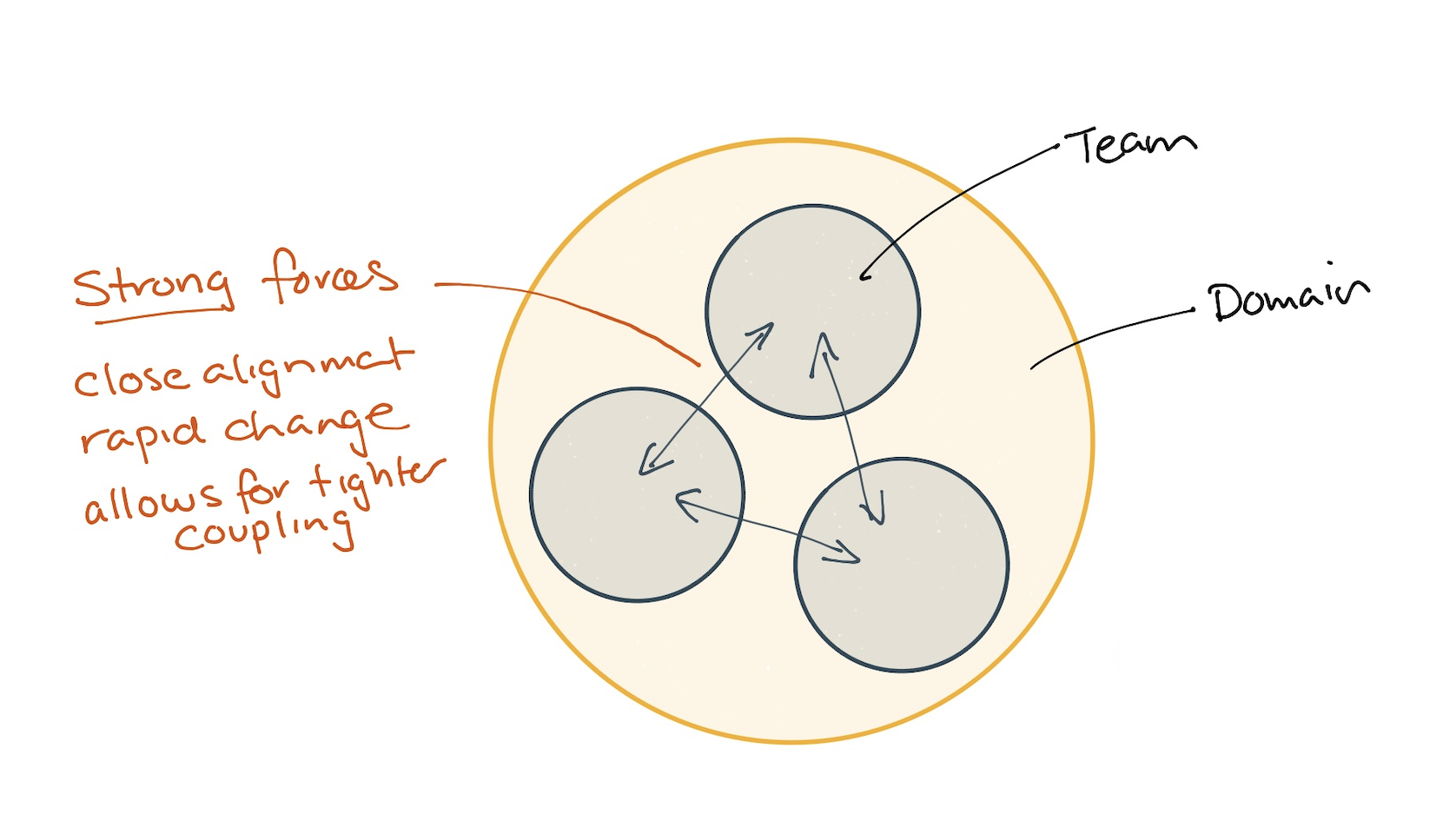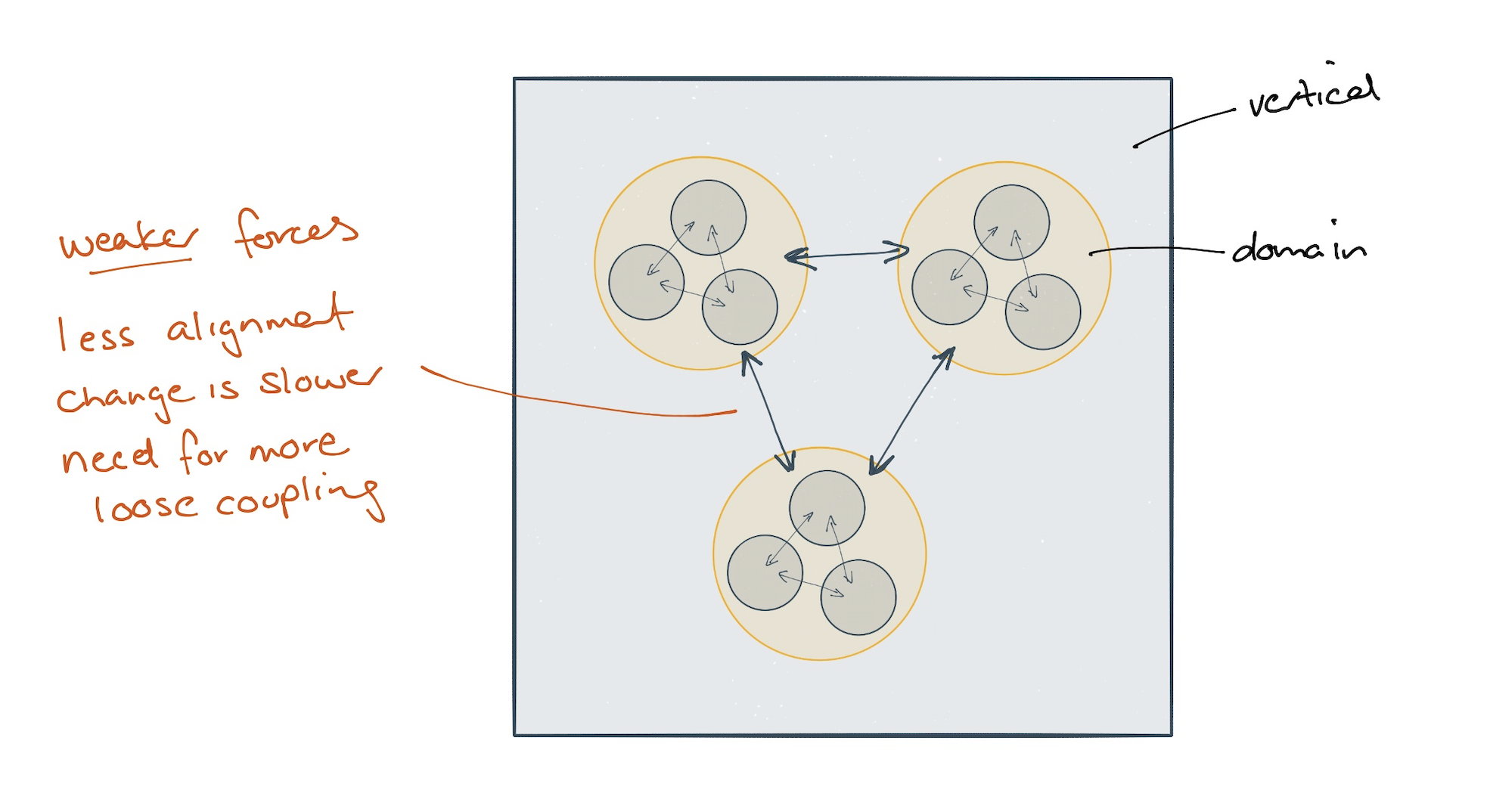The strong and weak forces of architecture
Good technical design decisions are very dependent on context. Teams that regularly work together on common goals are able to communicate regularly and negotiate changes quickly. These teams exhibit a strong force of alignment, and can make technology and design decisions that harness that strong force. As we zoom out in a larger organisation an increasingly weak force exists between teams and divisions that work independently and have less frequent collaboration. Recognising the differences in these strong and weak forces allows us to make better decisions and give better guidance for each level, allowing for more empowered teams that can move faster.
10 November 2021
Technology governance and what is considered ‘good architecture’ is mostly considered with a ‘one size fits all’ approach. Many organisations try to apply the same strict governance at all levels - limiting tech choices, and disempowering teams. Others have allowed teams complete autonomy at all levels, meaning teams are left to make their own choices with no constraints at all. Neither of those approaches are ideal.
Taking a specific example, we’ve long seen integration architects striving for the 'one true' integration approach at all levels of the architecture. They cite 'best practice', mandating extremely loose coupling, backward compatible interfaces, and careful encapsulation for every system interaction at all levels. This universal approach has created a lot of unnecessary complexity and delay in many cases - but how do you work out where it's ok to move faster and ease those requirements?
Teams at MYOB
At MYOB we have arranged our teams according to well-proven principles for modern digital product organisations. Teams are aligned to our product capabilities and business capabilities, and are responsible for all aspects of planning, delivery, maintenance, and support for their software and infrastructure.
Teams are grouped into Domains which bring together related capabilities, with some leadership and enabling roles working at the domain level. Domains are further grouped into much larger organisational units called Verticals. The verticals represent a major segment of our customer base.
There is much more to it of course, with supporting functions and internal platforms which provide scaffolding for the whole organisation to deliver effectively. However this simplified model is useful for reasoning about technology governance.

In this article I'd like to explain how this structure informs our tech choices and design decisions, with potentially different approaches being suitable depending on the scope (or ‘blast radius’) of the decision. The conceptual model I like is the forces of attraction between different parts of the organisation.
Within a domain = strong forces
Within a domain we have multiple teams, each being responsible for some capabilities and underlying systems within the domain. Sometimes this is perfectly aligned, with each team being custodians of a neatly bounded set of systems. More often this is imperfect in reality, with custodianship of some systems being shared across teams - often for legacy reasons. For teams within a domain, there is a very strong force of alignment.

The domain structure aims to bring together systems that are cohesive in function - they’re closely related, they deal with the same concepts, they rely on common domain expertise, and they quite often change at the same time in order to meet a customer need.
The members of a single team are usually working across the same systems, and so need a very clear and aligned way of working, standards, technology choices, and design directions. This is the strongest force of alignment.
Between teams in the same domain, alignment forces are still very strong. Sharing of knowledge is easy and fluid. Negotiating over system interactions e.g. schemas is relatively very easy. When a feature needs to be delivered that cuts across the systems in the domain, often the same people will implement ‘both sides’ of each point of integration.
This means that the ‘private’ interactions between the systems inside a domain - API calls, events, data files - can have tighter coupling without having as severe a cost. By allowing some tighter coupling, we can reduce the amount of effort that goes into versioning and backward compatibility and avoiding shared dependencies. Coupling between systems at a domain level is not always the evil monster that must be vanquished at all costs, in fact coupling at this scope can be a useful thing.
Within a vertical = weakened forces
In the middle ground we have our vertical structure, with multiple domains. The social distance between the people in one domain and another is getting stretched. This makes negotiation and reaching alignment more strained and slower, and so necessarily this impacts our technology choices and approaches.

Whole of organisation = weak forces
When we zoom out to all of the organisation - the force of alignment between the verticals is very weak indeed. It is quite hard to make changes atomically across the landscape - mostly because the prioritisation of work for each vertical is deliberately independent. Co-ordinating work at this level is necessarily much slower and limiting. This means our design decisions and approaches need to adapt accordingly.

How do we apply this model?
Lets make this model more concrete by exploring some areas of technology decision-making that may vary depending on their scope. The list below is not intended to be exhaustive - just a few interesting examples to consider.
Technology choices
Domain (strong force)
Within a single domain there should be a small set of technology choices agreed.
Often this follows Default Trial Retire for each class of technology required.
Informal governance through technology leadership is usually highly effective.
Vertical (weakened force)
At a vertical level there would be a slightly larger set of agreed technology choices, to cater for the differing needs of the multiple domains.
It is beneficial for the vertical to be able to move people closer to high priority work, so keeping aligned on technology is important here.
More formal sharing of solution options and proposals keeps choices aligned effectively.
Whole of org (weak force)
The weakest force for aligning and governing technology choices is at the whole of org level.
The MYOB technology radar sets direction in terms of preferred technologies.
Solution options and proposals encourage dialog and improve alignment.
Shared code and infrastructure
Domain (strong force)
Within a single domain, even across 3-5 teams, we should have high bandwidth communication and a short distance to empowered leadership.
This means that when a change needs to be made to shared code or infrastructure, we can quickly inform and prepare for the changes.
The coupling introduced by shared code and infrastructure has less impact, and the benefits often outweigh the costs.
Vertical (weakened force)
Sharing code, artefacts, and infrastructure can often be managed at a vertical level - but the drag introduced should be carefully monitored.
Whole of org (weak force)
Shared code at a whole of organisation level is limited to highly stable, highly useful things. Mostly these things are limited to libraries which can be distributed and versioned, and changed carefully.
Shared infrastructure is similar - at an org-wide level, shared infrastructure must have very high value, and be well-encapsulated (“as a service”, self-service). It should very rarely need a core change in response to a need from a single team.
Code Contribution models
Domain (strong force)
Within a single domain - with high degrees of alignment in terms of practices and technology - it can be quite reasonable for teams to contribute code across team boundaries, with a type of collective code ownership extending to the whole domain.
Custodianship of each system should still be clearly understood, usually best kept within one team.
Vertical (weakened force)
Within a vertical it is common for code contribution to happen across systems, e.g. pull requests in source control - with only small amounts of delay and re-work required.
Whole of org (weak force)
At the whole of org level, it is often quite difficult (and sometimes harmful) to effectively manage contributions that cross verticals.
This is particularly true where systems are complex in nature, highly critical or sensitive in terms of accuracy, performance, privacy and compliance.
When completely new system features are being established, it can work well to collaborate across verticals even doing pair-programming together. However as features are established and demand increases for changes from other verticals, investment is required to make those systems safe to extend and configure. Those changes are often architectural in nature - separating the ‘core’ and complex subsystems and introducing modularity to make extension easier to manage.
Integration Patterns
Domain (strong force)
Systems that are owned within a single domain are relatively easy to change in a closely co-ordinated way. For example this means (slightly) less effort needs to be burned on maintaining backwards-compatibility of interfaces.
Even ‘forbidden’ approaches like database-level integration will have less impact within the systems in a single domain. Although we shouldn’t build a system that way deliberately, if it exists then we can contain the impact within a single domain.
Vertical (weakened force)
Changes that must be co-ordinated across multiple domains within a vertical should be rare, but can be managed when absolutely necessary. Expand-contract changes to API contracts is quite effective where the impacts are contained within the vertical.
Whole of org (weak force)
APIs and interfaces (e.g. events) that are published to the whole of MYOB must have the highest attention to published schemas, versioning, backwards compatibility, contracts, and deprecation strategy.
The impact of highly-coupled integration (e.g. ETLs, database integration) is very high, and should be absolutely avoided.
Conclusion
In any organisation of non-trivial scale many dozens of technology decisions are made every day. We've strived for many years to enable and empower teams to make decisions closer to the work, without strict centralised governance over every single decision. Achieving 'aligned autonomy' is no easy feat, and requires constant balancing and adjustment. Simple models can help teams understand how to make good decisions in context. In this article I've described how at MYOB we've aligned our technology governance approach to our organisational structure and dynamics. Being aware of these forces of alignment within our organisation allows us to understand what is going to be easy and what is going to be hard, and make better technology choices as a result.
Acknowledgements
This article started out as an internal blog post within MYOB, which sparked some excellent conversations which helped me refine the idea. Thanks to MYOB colleague Heaton Cai and Thoughtworkers Rebecca Parsons, Birgitta Böckeler, Mark Taylor, and Peter Gillard-Moss for insightful feedback on the draft.
Significant Revisions
10 November 2021: published

